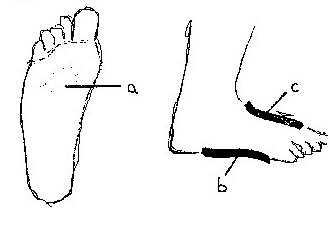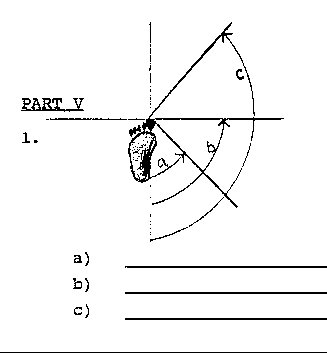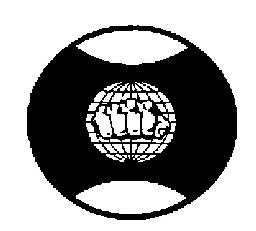
Part I
Fill in the blanks:
1. What is the name of this style of karate? ________________________________________
2. What is your teachers name? ________________________________________________
Part II
Match the Japanese terms with their English meanings:
| 1. Jodan uke | ...... | a) front kick |
| 2. Seiken | ...... | b) two |
| 3. Mae geri | ..... | c) upper block |
| 4. Gedan barai | ..... | d) fore fist |
| 5. Ni | ..... | e) round house |
| 6. Mawashi | ..... | f) lower parry |
True or false:
| 1. Mokuso means "meditation." | ...................................... |
| 2. Kiai means "I understand." | ...................................... |
| 3. Yoi means "ready." | ...................................... |
| 4. Chusoku means " knife edge of foot." | ...................................... |
| 5. Uraken means "elbow." | ...................................... |
Match the names of the parts of the foots with the labeled areas in the drawing below.
1. Sokuto _____________
2. Haisoku ____________
3. Chusoku ___________

Part I
Match the Japanese terms with their English meanings:
| 1. Half body | ............. | a. sankaku geri |
| 2. Pigeon toe stance | ............. | b. maki koni nage |
| 3. Backwards throw | ............. | c. sanchin dachi |
| 4. Inside thigh kick | ............. | d. hanmi |
| 5. Triangle kick | ............. | e. kumite no kata |
| 6. Roundhouse block | ............ | f. uranage |
| 7. Hook kick | ............ | g. kansetsu geri |
| 8. Fighting kata | ............ | h. mawashi uke |
| 9. Forward rolling kick | ............ | i. uchimomo geri |
| 10. Joint kick | ............ | j. kake geri |
Which block would be best to use for each of the following attacks:
| 1. L mae geri | ............. | a. L jodan uke |
| 2. R middle punch | ............. | b. L kansetsu geri |
| 3. R middle roundhouse kick | ............ | c. L gedan berai |
| 4. L upper punch | ............ | d. L chudan soto uke |
| 5. R roundhouse kick | ............ | e. hiji-hiza double block |
Part I
Give the Japanese term for the following:
1. Half body _______________________________
2. Spear hand ______________________________
3. Knife foot _______________________________
4. "Finishing touch ___________________________
5. Kick stance ______________________________
6. Heel ___________________________________
7. Left ___________________________________
8. Instep _________________________________
9. Back kick ______________________________
10. Arch _________________________________
Part II
Give the English meanings for the following terms:
1. Mawashi geri, yoko geri, chudan nihon zuki.
________________________________________________________________________________________
________________________________________________________________________________________
2. Kiba dachi, yonju go do, hiji uchi, uraken, gedan barai,chudan gyaku zuki.
_______________________________________________________________________________________
_______________________________________________________________________________________
Part III
Describe the following techniques:
1. Maki komi nagi _________________________________________________________________________
2. Hiji-hiza uke ___________________________________________________________________________
3. San kaku geri __________________________________________________________________________
4. Uchimomo geri _________________________________________________________________________
Part IV
Name the BLOCK in Japanese (saying whether right or left)which you would use to counter the following attacks.
1. Left mae geri ______________________________________
2. Left jodan mawashi geri ______________________________
3. Right chudan zuki ___________________________________
4. Right chudan mawashi geri ____________________________
5. Left ushiro geri _____________________________________
Part V
1. The diagram below shows the movement of the pivoting foot during three different roundhouse kicks. Label each kick and then give the part of the leg / foot used in each kick.
a. ________________
b. ________________
c. ________________

2. In the diagram below, draw the impact zone for a ushiro
mawashi kake geri to your opponent. Describe below how your kicking leg
looks before, during and after it passes through this zone.
Give the Japanese terms for the following:
1. Knife hand strike to collar bone __________________________
2. Turning backwards ___________________________________
3. Weaving in (towards opponent) _________________________
4. Fist edge __________________________________________
5. Descending elbow strike ______________________________
6. Jumping back kick __________________________________
7. Back roundhouse elbow strike _________________________
8. Inside low kick ____________________________________
9. Return to ready stance _______________________________
10. Quiet breathing ___________________________________
PART II
Your opponent attacks with a left gedan mawashi geri.
Describe how you would counter this attack using close, middle and long distance technique. Give the counter technique you would use then follow up with two moves–using different ones in each example. ( Use Japanese terms)
1. Close Distance: ______________________________________________________
____________________________________________________________________
2. Middle Distance: _____________________________________________________
____________________________________________________________________
3. Long Distance: ______________________________________________________
____________________________________________________________________
PART III
In the symbol of Ashihara Karate there are five main points representing what we strive to achieve. Number the five points on the symbol below and on the left write what each one stands for.
1. ____________________________________
2. ____________________________________
3. ____________________________________
4. ____________________________________
5. ____________________________________

Discuss the aspects of Karate in general and Ashihara Karate specifically that have affected you most in your training. Compare the reasons you began to train with those that influence your choice to continue. Are there any expectations you've had which have not been met? What have you learnt through your training which you didn't anticipate?
________________________________________________________________________
________________________________________________________________________
________________________________________________________________________
________________________________________________________________________
________________________________________________________________________
________________________________________________________________________
PART I
Give the Japanese terms for the following:
1. Forward leaning stance, circle block, middle reverse punch.
________________________________________________________________________
2. Skip away to absorb impact, upper double punch, sweep to supporting leg, middle roundhouse kick.
________________________________________________________________________
3. Ready, take your stance, bow to Shihan, bow to each other.
________________________________________________________________________
PART II
Explain the following terms and give their significance in Ashihara Karate:
1. Seika tanden: ___________________________________________________________
2. Mikiri: ________________________________________________________________
3. Todome _______________________________________________________________
PART III
Write down the Dojo kun:
1. ________________________________________________________________________
2. ________________________________________________________________________
3. ________________________________________________________________________
4. ________________________________________________________________________
5. ________________________________________________________________________
6. ________________________________________________________________________
PART IV
Explain the basic strategy of Ashihara Karate.
________________________________________________________________________
________________________________________________________________________
________________________________________________________________________
________________________________________________________________________
________________________________________________________________________
PART V
Describe what you believe are the areas of your training that you need to improve on.
________________________________________________________________________
________________________________________________________________________
________________________________________________________________________
________________________________________________________________________
________________________________________________________________________
PART I
Kancho said that for every technique there are check-points from the toes up to the head for good form. For each of the techniques below, give five check- points to watch for:
1. Seiken chudan zuki:
a )________________________________________________________________________
b )________________________________________________________________________
c ) ________________________________________________________________________
d ) ________________________________________________________________________
e ) ________________________________________________________________________
2. Chudan soto uke:
a ) ________________________________________________________________________
b) ________________________________________________________________________
c ) ________________________________________________________________________
d ) ________________________________________________________________________
e ) ________________________________________________________________________
3. Gedan barai:
a ) ________________________________________________________________________
b ) ________________________________________________________________________
c ) ________________________________________________________________________
d ) ________________________________________________________________________
e ) ________________________________________________________________________
4. Mawashi geri:
a ) ________________________________________________________________________
b ) ________________________________________________________________________
c ) ________________________________________________________________________
d ) ________________________________________________________________________
e ) ________________________________________________________________________
5. Ushiro mawashi kake geri:
a ) ________________________________________________________________________
b ) ________________________________________________________________________
c ) ________________________________________________________________________
d ) ________________________________________________________________________
e ) ________________________________________________________________________
PART II
Explain the benefits of basic training from a stationary stance:
________________________________________________________________________
________________________________________________________________________
________________________________________________________________________
________________________________________________________________________
________________________________________________________________________
PART III
Your opponent attacks with a right jodan mawashi geri. Give four examples of counter attacks. Begin each example with a different technique or block. Be specific about what Ashihara Karate position you are moving into, from what distance you are countering, etc. use combinations (two or three techniques) in each counter attack. Use Japanese terms wherever possible).
1. ________________________________________________________________________
2. ________________________________________________________________________
3. ________________________________________________________________________
4. ________________________________________________________________________
PART IV
Kancho stated that for any single technique in an attack, there are one hundred different ways to counter-attack. Discuss this, explaining what different elements of Ashihara Karate enables it to be true.
________________________________________________________________________
________________________________________________________________________
________________________________________________________________________
PART V
What is SABAKI?
________________________________________________________________________
________________________________________________________________________
________________________________________________________________________
________________________________________________________________________
Should you like to have the complete theory test handbook,
please write or call or Headquarters.
 Return
to Home Page
Return
to Home Page